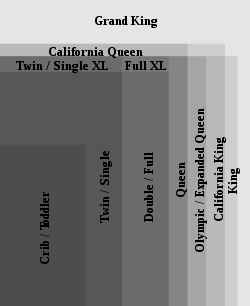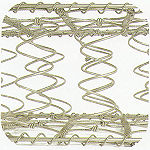- Mattress
-
For other uses, see Mattress (disambiguation).
A mattress is a manufactured product to sleep or lie on, consisting of resilient materials and covered with an outer fabric or ticking. In the developed world it is typically part of a bed set and is placed upon a foundation.
The derivation of the English word mattress is from the Arabic word "matrah" meaning "to throw down" or "place where something is thrown" or "mat, cushion." During the Crusades, Europeans adopted the Arabic method of sleeping on cushions thrown on the floor, and the word materas eventually descended into Middle English through the Romance languages.[1]
Though a mattress may be placed directly on the floor, it is usually placed on top of a bed base to be farther from the ground. The bed base may be solid, as in the case of a platform bed, or elastic, e.g. with an upholstered wood and wire box spring or a slatted foundation. Flexible bed bases can prolong the life of the mattress. Popular in Europe, a divan incorporates both mattress and foundation in a single upholstered, footed unit. Divans have at least one innerspring layer as well as cushioning materials. They may be sold with a secondary mattress and/or a removable "topper."
Early mattresses contained a variety of natural materials including straw, feathers or horse hair. In the first half of the 20th century, a typical mattress sold in North America had an innerspring core and cotton batting or fiberfill. Modern mattresses usually contain either an inner spring core or materials such as latex, viscoelastic or other flexible polyurethane foams. Other fill components include insulator pads over the coils that prevent the bed's upholstery layers from cupping down into the innerspring, as well as polyester fiberfill in the bed's top upholstery layers. Mattresses may also be filled with air or water, or a variety of natural fibers, such as in futons. In 1901 the English bed maker VI-Spring introduced the first ever individually wrapped pocketed spring coil mattress.
The typical mattress sold in North America today is an innerspring; however interest in all-foam beds and so-called hybrid beds—which include an innerspring plus high-end foams, such as visco-elastic or latex, in the comfort layers—is increasing. In Europe, polyurethane foam cores and latex cores have long been popular and make up a much larger proportion of the mattresses sold.[2]
Contents
History
 Photo on a 1940 USDA circular promoting home production of cotton mattresses
Photo on a 1940 USDA circular promoting home production of cotton mattresses
- Neolithic period: The mattress and bed are invented. Beds are raised off the ground to avoid drafts, dirt, and pests. The first mattress probably consists of a pile of leaves, grass, or possibly straw, with animal skins over it.
- 3600 B.C.: Beds made of goatskins filled with water are used in Persia.
- 3400 B.C.: Egyptians sleep on palm boughs heaped in the corners of their homes.
- 200 B.C.: Mattresses in Ancient Rome consist of bags of cloth stuffed with reeds, hay, or wool; the wealthy use feather stuffing.
- 15th century: During the Renaissance, mattresses are made of pea shucks, straw, or sometimes feathers, stuffed into coarse ticks, and covered with velvets and brocades.
- 16th and 17th centuries: Mattresses are stuffed with straw or down and placed atop a bed consisting of a timber frame with support latticeworks of rope or leather.
- Early 18th century: Mattresses are stuffed with cotton or wool.
- Mid 18th century: Mattress covers begin to be made of quality linen or cotton. The mattress cane box is shaped or bordered, and fillings include natural fibers such as coconut fibre, cotton, wool, and horsehair. The mattress is tufted or buttoned to attach the stuffing to the cover and the edges are stitched.
- Late 19th century: The box-spring is invented to distribute weight and act as a shock absorber, thereby lengthening the life of an innerspring mattress.
- 1926: Dunlop introduced a technology that turned vulcanized rubber sap into latex foam that became widely used until today as latex mattresses and latex pillows (hence the name Dunlopillo), at first it was only sold to royalties in the British Empire.
- 1930s: Innerspring mattresses and upholstered foundations become widely used, and artificial fillers become common. Encased coil spring mattresses, which consist of individual springs sewn into linked fabric bags, are introduced.
- 1940s: Air mattresses constructed of vulcanized rubber-coated fabric are introduced.
- 1960s: The modern waterbed is introduced and gains its first widespread use. Adjustable beds gain popularity.
- 1970s: NASA invents material that later becomes known as memory foam.[3]
- 1970s: A newly developed technology to produce foam rubber mattresses and pillows is introduced that enables factories to mass-produce latex foam and reduce the usage of rubber sap was introduced to the market and available for purchase.
- 1992: Tempur-Pedic introduces a mattress made from memory foam.
- 1992: Fibrelux introduces a mattress made from rubberized coir.
- 2000: Simmons Bedding Co. invents the "no-flip" mattress, a one-sided construction style that has since been adopted by most North American mattress manufacturers.[4]
Mattress dimensions
Mattresses thicknesses range from four to eighteen inches (10 to 46 cm).
International Mattress Sizes[5] Denomination The Americas
inches (cm)U.K.
inches (cm)E.U. (Continental)
cm (inches)Asia (Thailand)
cm (inches)Crib / Toddler 271⁄4 × 515⁄8 in (69 × 131 cm) 271⁄2 × 55 in (70 × 140 cm) cotbed Cot/Mini Single (UK: small single) 30 × 70 in (76 × 178 cm) 30 × 69 in (76 × 175 cm) UK: small single (small single is used to mean several different sizes) 30 × 75 in (76 × 191 cm) Modern Cot 30 × 74 in (76 × 188 cm) Twin/Single (UK: single) 39 × 75 in (99 × 191 cm) 36 × 75 in (91 × 191 cm) 90 × 190 cm (35 × 75 in) 107 × 198 cm (42 × 78 in) Twin/Single XL 39 × 80 in (99 × 203 cm) 42 × 75 in (107 × 191 cm) Double/Full (UK: small double) 53 × 74 in (135 × 188 cm) 48 × 75 in (122 × 191 cm) 140 × 190 cm (55 × 75 in) 122 × 198 cm (48 × 78 in) Double/Full XL (UK: double) 53 × 80 in (135 × 203 cm) 54 × 75 in (137 × 191 cm) Queen 60 × 80 in (152 × 203 cm) 160 × 200 cm (63 × 79 in) Olympic/Expanded Queen (novelty size by Simmons) 66 × 80 in (168 × 203 cm) California Queen (primarily a wood-framed water bed size, becoming obsolete) 60 × 84 in (152 × 213 cm) King (UK: King) 76 × 80 in (193 × 203 cm) 60 × 78 in (152 × 198 cm) 180 × 200 cm (71 × 79 in) 183 × 198 cm (72 × 78 in) California King 72 × 84 in (183 × 213 cm) Super King (UK: Super King) 72 × 78 in (183 × 198 cm) Grand King (novelty size by Select Comfort air beds) 80 × 98 in (203 × 249 cm) 
A comparative diagram of some U.S. mattresses
A comparative diagram of some UK mattressesComponents of an innerspring mattress
A common innerspring mattress consists of three components: the spring core, the foundation, and the upholstery layers.[6]
Spring mattress core
The core of the mattress supports the sleeper’s body. Modern spring mattress cores, often called "innersprings," are made up of steel coil springs, or "coils."
The gauge of the coils is another factor which determines firmness and support. Coils are measured in quarter increments. The lower the number, the thicker the spring. In general, higher-quality mattress coils have a 14-gauge (1.63 mm) diameter. Coils of 14 to 15.5-gauge (1.63 to 1.37 mm) give more easily under pressure, while a 12.5-gauge (1.94 mm) coil, the thickest typically available, feels quite firm.
Connections between the coils help the mattress retain its shape. Most coils are connected by interconnecting wires; encased coils are not connected, but the fabric encasement helps preserve the mattress shape.
Here are five types of mattress coils:
- Bonnell coils are the oldest and most common. First adapted from buggy seat springs of the 19th century, they are still prevalent in mid-priced mattresses. Bonnell springs are a knotted, round-top, hourglass-shaped steel wire coil. When laced together with cross wire helicals, these coils form the simplest innerspring unit, also referred to as a Bonnell unit.
- Marshall coils, also known in the industry as wrapped or encased or pocketed coils, are thin-gauge, barrel-shaped, knotless coils individually encased in fabric pockets--normally a fabric from man-made, nonwoven fiber. In the case of Beautyrest, high carbon magnesium is added, while the steel itself remains untempered. Some manufacturers precompress these coils, which makes the mattress firmer and allows for motion separation between the sides of the bed.
- Offset coils are an hourglass type coil on which portions of the top and bottom convolutions have been flattened. In assembling the innerspring unit, these flat segments of wire are hinged together with helical wires. The hinging effect of the unit is designed to conform to body shape. LFK coils are an unknotted offset coil with a cylindrical or columnar shape.
- Continuous coils (the Leggett & Platt brand name is Mira-coil) is an innerspring configuration in which the rows of coils are formed from a single piece of wire. They work in a hinging effect similar to that of offset coils.
The bed coil spring was patented by Louis Andrew Vargha.
Air mattresses
Air mattresses use one or more air chambers instead of springs to provide support. Quality and price can range from inexpensive ones used occasionally for camping, all the way up to high-end luxury beds. Air mattresses designed for typical bedroom use cost about the same as inner-spring mattresses with comparable features.
Air mattresses as regular beds
Several companies currently produce adjustable firmness air mattresses. In 1981, Comfortaire began manufacturing and marketing an air bed that looked like a conventional inner spring bed, but allowed users to adjust the firmness. Select Comfort patented a variant and began marketing them in 1987. Today, Select Comfort produces the "Sleep Number" bed which, in some models and sizes, allows independent adjustment of each side of the bed for comfort and firmness.
Adjustable air mattresses come in a variety of models from basic, no-frills ones that measure about 7" in height, to high-profile, 15" tall hybrids that contain several types of foam, pillow tops, and digital pumps with memory, for individual pressure settings.
Air bladder construction varies from a simple polyethylene bag to internally baffled, multiple chambers of latex (vulcanized rubber) or vinyl with bonded cotton exteriors.[7] Mattresses have a layer of foam above the air chambers for added cushioning. The air chambers, top and sidewall foam all sit inside a removable two piece cover that looks like the outside of a standard innerspring mattress. These high-end luxury air beds are also known as soft-sided air beds.
Air mattresses for medical use
Medical versions of adjustable firmness mattresses have special control mechanisms. In 1990s, the industry began producing self-adjusting air beds that automatically change their pressure periodically, and/or inflate and deflate several air chambers alternately. The intention of these periodic changes is to reduce problems with decubitus ulcers (bed sores), though it is still a subject of research how effective this is.[8]
Self-inflating air mattresses
Air mattresses for camping are often filled with foam. The foam itself provides little support, but will expand when the mattress' air valve is opened, and draw in air, so the mattress will (nearly) inflate by itself. This is especially useful for hikers, as unlike normal air mattresses no pump is needed for inflating. A common brand is Therm-a-Rest.
Foam mattresses
All-foam mattresses use different weights and densities of petrochemical-based flexible polyurethane foams[9] and visco-elastic foams or memory foam, and latex rubber foams. A number of mattress manufacturers have incorporated polyurethane and visco-elastic foams with a portion of plant-based content.[10]
In the 1980s FoamCoil sold mattresses containing coil springs encased in polyurethane.
Latex foam in mattresses is generally a blend of the sap of the Hevea brasiliensis tree and synthetic latex, which is derived from petrochemicals and other substances and fillers. Latex foam is produced using either the Talalay or the Dunlop process.[11] Each provides a different feel. Dunlop is generally a firmer foam, Talalay is softer. Talalay is more expensive as its production is more resource intensive. One hundred percent natural latex foam mattresses are also available from niche mattress makers.[12]
Memory foam mattresses use conforming visco-elastic foam over firmer polyurethane base foam. Different feels and comfort levels are achieved by varying the thickness, weight and formulation of the visco-elastic foams and the base foams. Latex and memory foam mattresses each provide a unique feel.
Foundation
There are three main types of foundation.
- A box-spring consists of a rigid frame containing extra-heavy-duty springs. This foundation contributes to softer support and a bouncier mattress. Because box-springs can allow mattresses to sag, many manufacturers add high-density block foam underneath the coils or provide a rigid foundation instead.
- A traditional wood foundation is usually made of softwood, such as pine, or hardwood. It usually has seven or eight support slats covered with paperboard or beaverboard. This foundation, called a zero-deflection unit or an "Ortho Box" in the bed industry, increases the feeling of firmness and stability.
- A grid foundation is a combination of steel and wood.
Upholstery layers
Upholstery layers cover the mattress and provide cushioning and comfort. Some manufacturers call the mattress core the "support layer" and the upholstery layer the "comfort layer." The upholstery layer consists of three parts: the insulator, the middle upholstery, and the quilt.
The insulator separates the mattress core from the middle upholstery. It is usually made of fibre or mesh and is intended to keep the middle upholstery in place.
The middle upholstery comprises all the material between the insulator and the quilt. It is usually made from materials which are intended to provide comfort to the sleeper, including regular foam, viscoelastic foam, felt, polyester fibres, cotton fibers, convoluted ("egg-crate") foam, and non-woven fibre pads.
The quilt is the top layer of the mattress. Made of light foam or fibres stitched to the underside of the ticking, it provides a soft surface texture to the mattress and can be found in varying degrees of firmness. The protective fabric cover which encases the mattress is called ticking. It is usually made to match the foundation and comes in a wide variety of colors and styles. Most ticking is made of synthetic fibres like polyester, or acrylic; or of natural materials such as latex, cotton, silk, and wool.
The protective fabric cover which encases the mattress is called ticking. It is usually designed to coordinate with the foundation border fabric and comes in a wide variety of colors and styles. Mattress fabrics can be knits, damask or printed wovens, or inexpensive nonwovens. During the past decade, along with the rise in popularity of all-foam beds, stretchy knit ticking on the bed's top panel has become a standard look on both innerspring and foam beds. Most ticking is made with polyester yarns. More expensive mattress fabrics may contain a combination of polyester with rayon, cotton, silk, wool or other natural yarns.[13]
Quality
Many parameters determine mattress quality. Laboratory test methods have been established for some of these parameters, such as pressure distribution, skin microclimate, hygiene, edge support, and long-term stability. Many of these have been developed by Dr. Duncan Bain, working on behalf of the UK's Medicines and Healthcare products Regulatory Agency.[14]
Other parameters, such as firmness, are more specific to the sleeper. In general, firm mattresses are recommended for stomach and some back sleepers, soft mattresses are recommended for side sleepers, and medium mattresses are recommended for the majority of back sleepers.[citation needed] Some brands offer mattresses with one softer side and one firmer side, or with adjustable firmness levels, to accommodate sleepers who share a bed.
Maintenance and care
A quality innerspring mattress should last between 7 and 10 years before it needs to be replaced. Memory foam and latex models should last between 10 and 20 years, depending on the manufacturer, the quality of the bedding, and the vigorousness of use. This is an approximation, as many factors affect the lifespan of a mattress.
Mattresses should be placed atop a firm base to prevent sagging. A new mattress should be rotated once a month for the first six months and once every 2–3 months after that. Double sided, or two sided, mattresses should be alternately flipped and rotated. Manufacturers suggest that one rotate (spin) the box springs or foundation twice a year. Folding and bending of the mattress should be avoided if possible, as should heavy wear in one spot and excessive weight on the handles. Mattresses should not be soaked, lest mildew develop inside the upholstery; instead, they can be cleaned with a vacuum or with mild surface cleanser and a slightly damp cloth. Mattress Protectors help prevent stains and soiling of the ticking.
A mattress may absorb up to 3 gallons of sweat and other fluids in its lifetime, causing wear and stains. Once a mattress no longer feels supportive and instead seems to contribute to body pain or stiffness, it should be replaced. Some symptoms of a broken or worn out mattress include springs which can be felt poking through the upholstery layer, visible permanent sagging or deformity, lumpiness, and excessive squeaking.
Queen and larger size mattress sets should be supported by a 5- or 6-leg frame. A queen size mattress is 60 inches wide and requires more support than smaller sizes. If using a headboard/footboard style bed, one should use at least five wood slats with three positioned primarily in the center third of the bed.
See also
- Bed
- Bed frame
- Box-spring
- Bedding
- Duvet
- Cushion
- Futon
- International Sleep Products Association
- Law label – The "Under Penalty of Law" label
- Matratzenlager - mattress room in mountain huts
- Mattress protector
- Orthopedic mattress
- Pillow
- Platform bed
- Sleep
- Sleeping pad
- Standard sizes of commercial bedding
- Underpad
Notes
- ^ "Mattress: Word History." The American Heritage Dictionary.
- ^ Nelles, Barbara. "The Inside Story." BedTimes Magazine. July 2009. Retrieved 2011-9-1
- ^ Aerospace Technology Innovation May/June 1998
- ^ "Company History." Simmons website, www.simmons.com. Retrieved 2011-8-21.
- ^ based on "Common Mattress Dimensions". Precious Bedding Company. http://www.preciousbedding.com/mattress-size-chart.php.
- ^ Haex, Bart (2005). Back and Bed: Ergonomic Aspects of Sleeping. CRC Press. ISBN 0415332974.
- ^ Nelles, Barbara. "What's in the air? Category clearly getting off the ground." BedTimes Magazine. June 2006.
- ^ Alternating pressure air mattresses as prevention for pressure ulcers: A literature review International Journal of Nursing Studies, Volume 45, Issue 5, Pages 784-801 (May 2008)
- ^ "Flexible Polyurethane Foams (FPFs) Used in Upholstered Furniture and Bedding." American Chemistry Council: Center for the Polyurethanes Industry. 2008. Retrieved Aug. 15, 2011.
- ^ "Product Watch: Green foams grabbing the spotlight." BedTimes Magazine. Feb. 2010. Retrieved Aug. 15, 2011.
- ^ "The future of foam: An ever-widening sphere of influence." BedTimes Magazine. February 2003. Retrieved Aug. 15, 2011.
- ^ "Trends in springs and foam: the core components." BedTimes Magazine. August 2011. Retrieved Aug. 15, 2011.
- ^ Nelles, Barbara. "Dress Up: Mattress Fabrics take on many roles." BedTimes Magazine, November 2009. Retrieved 2011-8-21.
- ^ Bain, Duncan. “Pressure Reducing Mattresses.” MHRA. April 2004.
Bedding Bed types Bassinet · Box-bed · Bunk bed · Cage bed · Camp bed · Canopy bed · Couch · Couch bed · Four poster bed · Futon · Hammock · Hospital bed · Infant bed · Lit a la turque · Manjaa · Murphy bed · Petate · Platform bed · Sleigh bed · Sofa bed · Toddler bed · Trundle bed · Waterbed · DaybedBed components Air mattress · Bed base · Bed frame · Bed skirt · Bed warmer · Box-spring · Bunkie board · Cot side · Featherbed · Headboard · Mattress · Mattress pad · Mattress protector · Memory foam · Nightstand · Orthopedic mattress · SheetBlankets Afghan · Button blanket · Comforter · Duvet · Electric blanket · Fire blanket · Hudson's Bay point blanket · Patchwork quilt · Photo blanket · Pierzyna · Quilt · Security blanket · Silk comforterPillows Acupressure pillow · Bamboo wife · Bolster · Contour leg pillow · Cushion · Dakimakura · Eye pillow · Love pillow · Orthopedic pillow · Phonetic pillow · Sex pillow · Speaker pillow · Throw pillow
Categories:- Arabic words and phrases
- Bedding
Wikimedia Foundation. 2010.



